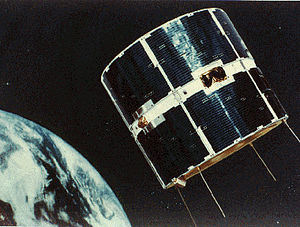COS-B was the first European Space Research Organisation (ESRO) mission to study cosmic gamma ray sources. COS-B was first put forward by the European scientific community in the mid-1960s and approved by the ESRO council in 1969. The mission consisted of a satellite containing gamma-ray detectors, which was launched by NASA on behalf of the ESRO on 9 August 1975. The mission was completed on 25 April 1982, after the satellite had been operational for more than 6.5 years, four years longer than planned and had increased the amount of data on gamma rays by a factor of 25. Scientific results included the 2CG Catalogue listing around 25 gamma ray sources and a map of the Milky Way. The satellite also observed the X-ray binary Cygnus X-3.
 Cos-B, a satellite to study cosmic gamma-rays | |
| Mission type | Astronomy |
|---|---|
| Operator | ESA |
| COSPAR ID | 1975-072A |
| SATCAT no. | 08062 |
| Mission duration | 2.5 years (planned) 10 years, 5 months and 8 days (achieved) |
| Start of mission | |
| Launch date | 9 August 1975, 01:48:00 UTC |
| Rocket | Delta 2913 |
| Launch site | Vandenberg Air Force Base, SLC-2W |
| End of mission | |
| Decay date | 18 January 1986 |
| Orbital parameters | |
| Reference system | Geocentric orbit |
| Regime | Low Earth orbit |
Launch
editCOS-B was launched from Vandenberg Air Force Base on 9 August 1975 on a Delta 2913 rocket.
External links
edit- Cos-B overview at esa.int
- Cos-B overview at ESA science & technology pages
- Scientific results of Cos-B at ESA
- Cos-B overview at NASA